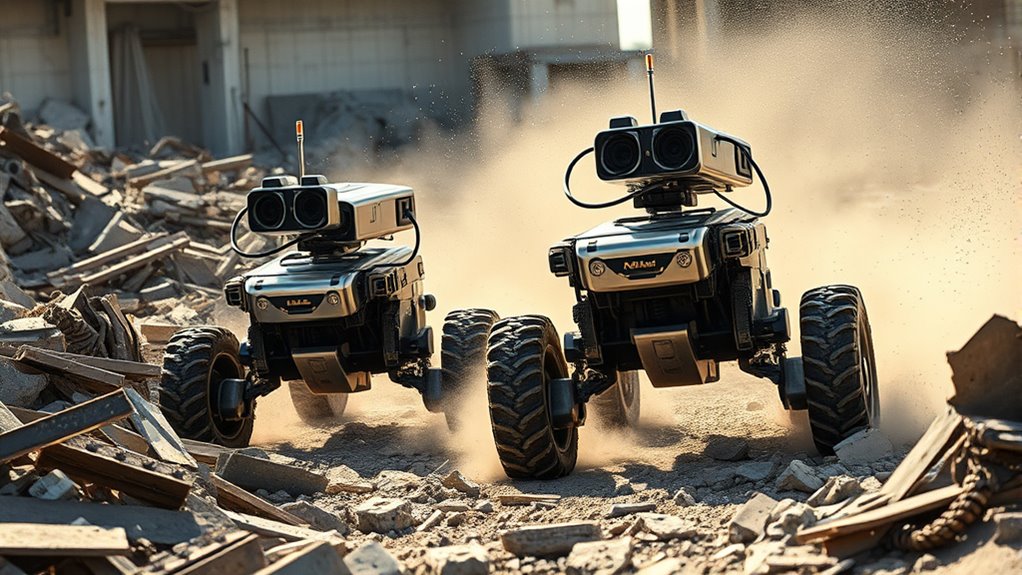Autonomous search and rescue robots are revolutionizing disaster response by maneuvering complex, hazardous environments without human help. They use advanced obstacle detection systems, combining sensors and real-time data processing to identify hazards like debris or unstable structures. This enables quick route adjustments and safe operation amid unpredictable conditions. Their ability to adapt ensures mission success while minimizing risks. If you keep exploring, you’ll discover how these innovations could redefine future rescue efforts.
Key Takeaways
- Advanced obstacle detection systems enable rescue robots to navigate complex, unpredictable environments safely and efficiently.
- Sensor fusion integrates multiple sensor data for real-time hazard identification and dynamic environment adaptation.
- Autonomous navigation and obstacle avoidance improve response time and mission success in time-critical rescue operations.
- Robust safety measures and AI security are essential to prevent system failures and ensure reliable rescue missions.
- Continuous technological advancements are expanding the capabilities and effectiveness of autonomous search and rescue robots.

Obstacle detection plays a critical role in guaranteeing these robots operate safely and effectively. You need to understand that obstacle detection systems use a combination of sensors to identify hazards like debris, unstable structures, or even moving objects. When the robot detects an obstacle, it quickly recalculates its path, choosing the safest and most efficient route forward. This capability minimizes the risk of the robot becoming stuck or damaged, which is essential when every second counts in rescue missions. Your awareness of how obstacle detection works helps you appreciate the importance of real-time data processing and sensor fusion, which allow the robot to respond instantly to changing conditions. Additionally, understanding potential vulnerabilities in these systems is vital to developing robust safety measures that ensure reliable operation in unpredictable environments.
Frequently Asked Questions
How Do Robots Prioritize Search Areas in Disaster Zones?
You program robots to prioritize search areas using navigation algorithms and AI decision making. They analyze data like debris patterns, victim signals, and hazard zones to determine where to search first. By constantly updating their assessments, the robots efficiently cover the most critical areas. This adaptive process helps guarantee they find survivors quickly while avoiding dangers, making their search efforts more effective and saving lives.
What Are the Main Challenges in Developing Autonomous Rescue Robots?
You face challenges like balancing ethical dilemmas and legal considerations, especially when deploying rescue robots. For example, ensuring the robots make morally sound decisions during life-saving operations can be complex. Developing reliable sensors and AI algorithms adds technical hurdles. You must also navigate legal issues around accountability if a robot malfunctions or causes harm, making it essential to create clear regulations to guide autonomous rescue operations.
How Do Robots Communicate With Human Rescue Teams?
You’ll find that robots communicate with human rescue teams using specialized communication protocols, ensuring clear and reliable robot language exchange. They often transmit data through radio or wireless links, allowing real-time updates on their status, environment, and findings. These protocols help bridge the gap between machine and human language, enabling seamless coordination. This way, rescue teams stay informed, making operations more efficient and increasing the chances of saving lives.
What Sensors Are Most Effective for Search and Rescue Missions?
You should prioritize thermal imaging and acoustic sensors for search and rescue missions. Thermal imaging detects heat signatures, helping you locate victims in darkness or debris. Acoustic sensors pick up sounds like calls for help or movement, guiding your team efficiently. Combining these sensors enhances detection, ensuring swift, safe rescues. Trust these tools to transform your rescue efforts, turning technology into a life-saving advantage when every second counts.
How Is Robot Durability Tested in Extreme Conditions?
You test robot durability in extreme conditions through rigorous environmental testing, which assesses material resilience under heat, cold, moisture, and abrasion. You simulate real-world scenarios, exposing robots to mud, water, and impact forces to guarantee they withstand harsh environments. By analyzing performance data, you identify weak points, then reinforce materials or design, ensuring your rescue robots remain functional and reliable when they face the toughest situations.
Conclusion
As you stand on the brink of this technological revolution, remember that autonomous search and rescue robots are your modern-day knights, bravely exploring danger to save lives. They’re not just machines but a glimpse into a future where humanity’s courage and innovation unite. Just like Icarus reaching for the sun, you must balance ambition with caution, ensuring these marvels serve us wisely without overreaching. The next frontier awaits, and it’s yours to shape.









